Marketing Management Report: Theory and Simulation Analysis
VerifiedAdded on 2022/09/09
|11
|2487
|23
Report
AI Summary
This report provides an in-depth analysis of marketing management, focusing on the application of marketing theory in decision-making processes. The report begins by exploring the usefulness of the marketing mix theory, examining its elements such as product, price, place, promotion, people, physical evidence, and process, and how they contribute to effective marketing strategies. It then delves into the evaluation of overall performance in a marketing simulation, utilizing the segmentation, targeting, and positioning (STP) framework. The report highlights how STP tools align products with the right customers and reduce costs by focusing marketing efforts. The analysis includes an examination of segmentation based on demography, geography, and behavior, targeting specific customer groups, and positioning products to build brand image. The report concludes by emphasizing the importance of integrating the 7Ps of marketing with STP to improve decision-making and achieve competitive advantage, underscoring the significance of making the right marketing decisions in the current business environment. The report also references several academic sources to support its analysis.

Running head: MARKETING MANAGEMENT
Marketing Management
Name of the Student
Name of the University
Author note
Marketing Management
Name of the Student
Name of the University
Author note
Paraphrase This Document
Need a fresh take? Get an instant paraphrase of this document with our AI Paraphraser
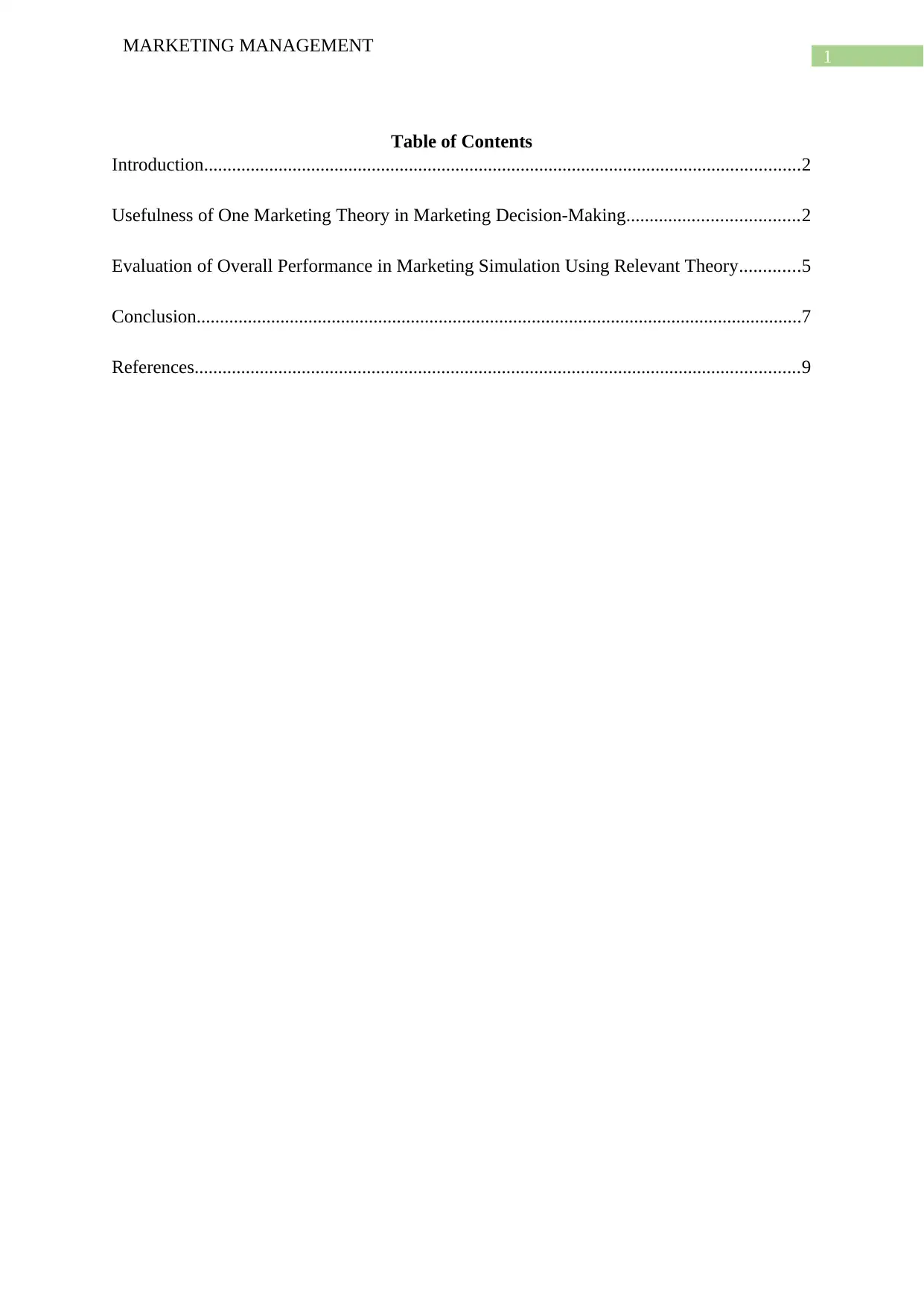
1
MARKETING MANAGEMENT
Table of Contents
Introduction................................................................................................................................2
Usefulness of One Marketing Theory in Marketing Decision-Making.....................................2
Evaluation of Overall Performance in Marketing Simulation Using Relevant Theory.............5
Conclusion..................................................................................................................................7
References..................................................................................................................................9
MARKETING MANAGEMENT
Table of Contents
Introduction................................................................................................................................2
Usefulness of One Marketing Theory in Marketing Decision-Making.....................................2
Evaluation of Overall Performance in Marketing Simulation Using Relevant Theory.............5
Conclusion..................................................................................................................................7
References..................................................................................................................................9
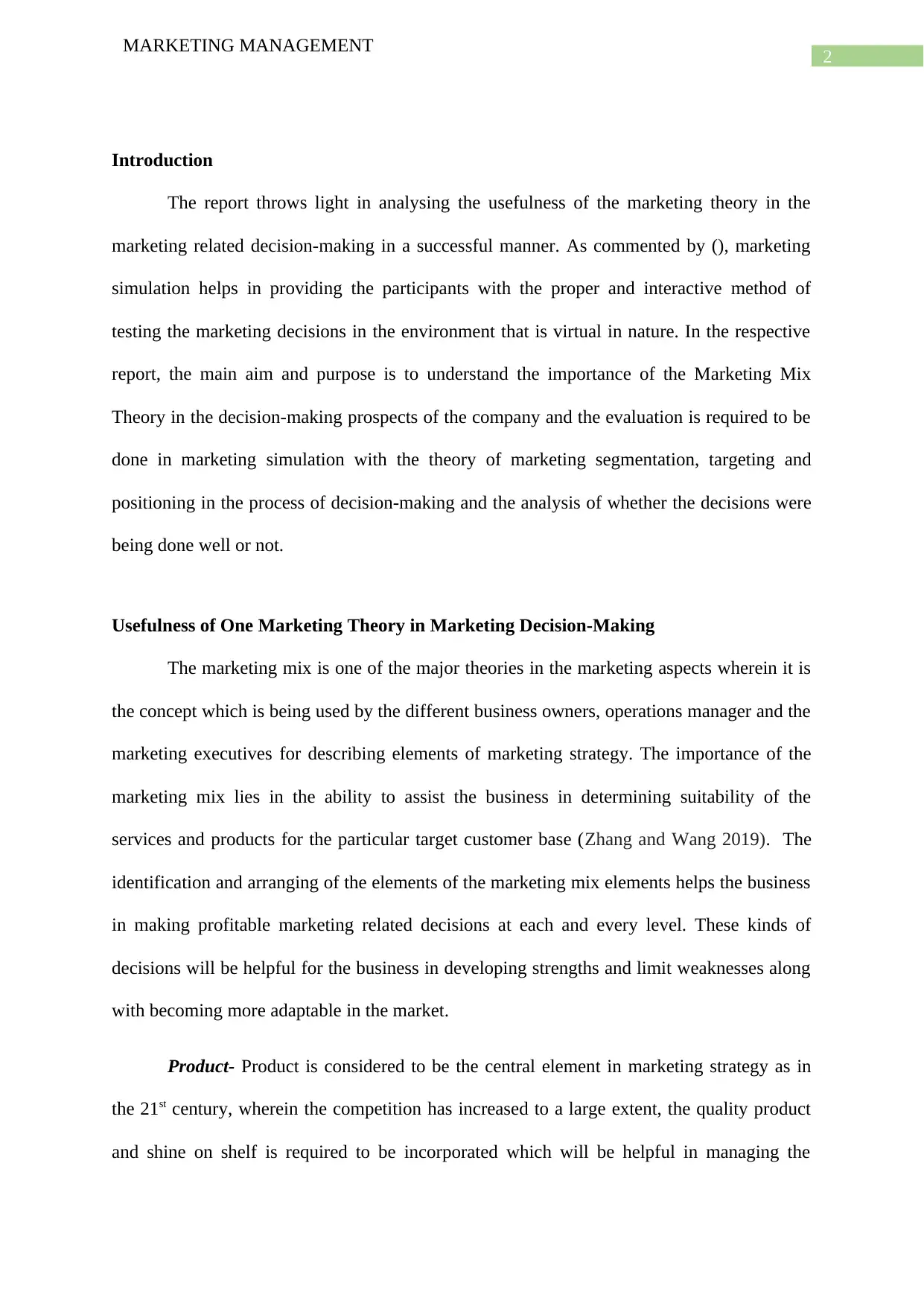
2
MARKETING MANAGEMENT
Introduction
The report throws light in analysing the usefulness of the marketing theory in the
marketing related decision-making in a successful manner. As commented by (), marketing
simulation helps in providing the participants with the proper and interactive method of
testing the marketing decisions in the environment that is virtual in nature. In the respective
report, the main aim and purpose is to understand the importance of the Marketing Mix
Theory in the decision-making prospects of the company and the evaluation is required to be
done in marketing simulation with the theory of marketing segmentation, targeting and
positioning in the process of decision-making and the analysis of whether the decisions were
being done well or not.
Usefulness of One Marketing Theory in Marketing Decision-Making
The marketing mix is one of the major theories in the marketing aspects wherein it is
the concept which is being used by the different business owners, operations manager and the
marketing executives for describing elements of marketing strategy. The importance of the
marketing mix lies in the ability to assist the business in determining suitability of the
services and products for the particular target customer base (Zhang and Wang 2019). The
identification and arranging of the elements of the marketing mix elements helps the business
in making profitable marketing related decisions at each and every level. These kinds of
decisions will be helpful for the business in developing strengths and limit weaknesses along
with becoming more adaptable in the market.
Product- Product is considered to be the central element in marketing strategy as in
the 21st century, wherein the competition has increased to a large extent, the quality product
and shine on shelf is required to be incorporated which will be helpful in managing the
MARKETING MANAGEMENT
Introduction
The report throws light in analysing the usefulness of the marketing theory in the
marketing related decision-making in a successful manner. As commented by (), marketing
simulation helps in providing the participants with the proper and interactive method of
testing the marketing decisions in the environment that is virtual in nature. In the respective
report, the main aim and purpose is to understand the importance of the Marketing Mix
Theory in the decision-making prospects of the company and the evaluation is required to be
done in marketing simulation with the theory of marketing segmentation, targeting and
positioning in the process of decision-making and the analysis of whether the decisions were
being done well or not.
Usefulness of One Marketing Theory in Marketing Decision-Making
The marketing mix is one of the major theories in the marketing aspects wherein it is
the concept which is being used by the different business owners, operations manager and the
marketing executives for describing elements of marketing strategy. The importance of the
marketing mix lies in the ability to assist the business in determining suitability of the
services and products for the particular target customer base (Zhang and Wang 2019). The
identification and arranging of the elements of the marketing mix elements helps the business
in making profitable marketing related decisions at each and every level. These kinds of
decisions will be helpful for the business in developing strengths and limit weaknesses along
with becoming more adaptable in the market.
Product- Product is considered to be the central element in marketing strategy as in
the 21st century, wherein the competition has increased to a large extent, the quality product
and shine on shelf is required to be incorporated which will be helpful in managing the
⊘ This is a preview!⊘
Do you want full access?
Subscribe today to unlock all pages.

Trusted by 1+ million students worldwide
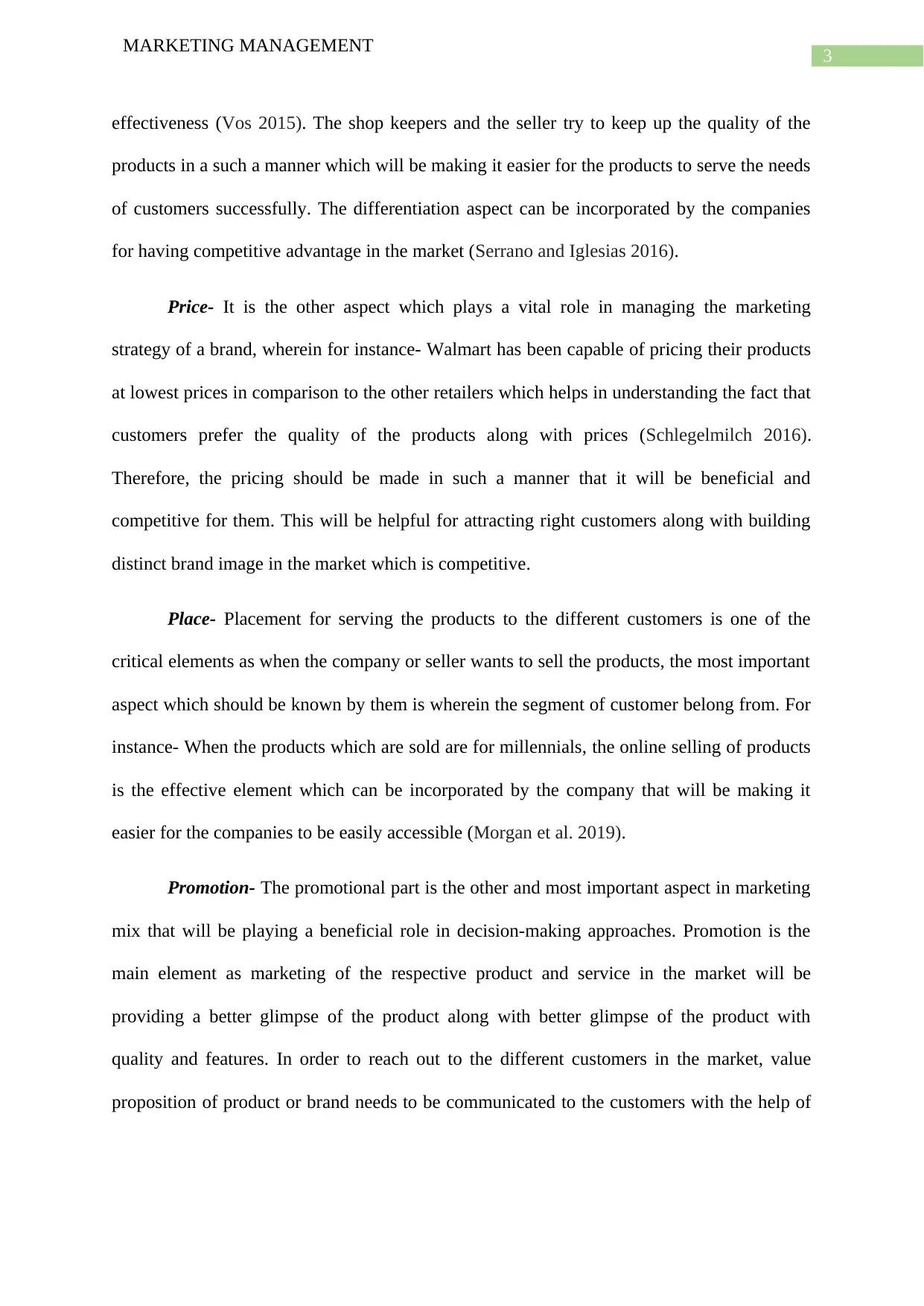
3
MARKETING MANAGEMENT
effectiveness (Vos 2015). The shop keepers and the seller try to keep up the quality of the
products in a such a manner which will be making it easier for the products to serve the needs
of customers successfully. The differentiation aspect can be incorporated by the companies
for having competitive advantage in the market (Serrano and Iglesias 2016).
Price- It is the other aspect which plays a vital role in managing the marketing
strategy of a brand, wherein for instance- Walmart has been capable of pricing their products
at lowest prices in comparison to the other retailers which helps in understanding the fact that
customers prefer the quality of the products along with prices (Schlegelmilch 2016).
Therefore, the pricing should be made in such a manner that it will be beneficial and
competitive for them. This will be helpful for attracting right customers along with building
distinct brand image in the market which is competitive.
Place- Placement for serving the products to the different customers is one of the
critical elements as when the company or seller wants to sell the products, the most important
aspect which should be known by them is wherein the segment of customer belong from. For
instance- When the products which are sold are for millennials, the online selling of products
is the effective element which can be incorporated by the company that will be making it
easier for the companies to be easily accessible (Morgan et al. 2019).
Promotion- The promotional part is the other and most important aspect in marketing
mix that will be playing a beneficial role in decision-making approaches. Promotion is the
main element as marketing of the respective product and service in the market will be
providing a better glimpse of the product along with better glimpse of the product with
quality and features. In order to reach out to the different customers in the market, value
proposition of product or brand needs to be communicated to the customers with the help of
MARKETING MANAGEMENT
effectiveness (Vos 2015). The shop keepers and the seller try to keep up the quality of the
products in a such a manner which will be making it easier for the products to serve the needs
of customers successfully. The differentiation aspect can be incorporated by the companies
for having competitive advantage in the market (Serrano and Iglesias 2016).
Price- It is the other aspect which plays a vital role in managing the marketing
strategy of a brand, wherein for instance- Walmart has been capable of pricing their products
at lowest prices in comparison to the other retailers which helps in understanding the fact that
customers prefer the quality of the products along with prices (Schlegelmilch 2016).
Therefore, the pricing should be made in such a manner that it will be beneficial and
competitive for them. This will be helpful for attracting right customers along with building
distinct brand image in the market which is competitive.
Place- Placement for serving the products to the different customers is one of the
critical elements as when the company or seller wants to sell the products, the most important
aspect which should be known by them is wherein the segment of customer belong from. For
instance- When the products which are sold are for millennials, the online selling of products
is the effective element which can be incorporated by the company that will be making it
easier for the companies to be easily accessible (Morgan et al. 2019).
Promotion- The promotional part is the other and most important aspect in marketing
mix that will be playing a beneficial role in decision-making approaches. Promotion is the
main element as marketing of the respective product and service in the market will be
providing a better glimpse of the product along with better glimpse of the product with
quality and features. In order to reach out to the different customers in the market, value
proposition of product or brand needs to be communicated to the customers with the help of
Paraphrase This Document
Need a fresh take? Get an instant paraphrase of this document with our AI Paraphraser
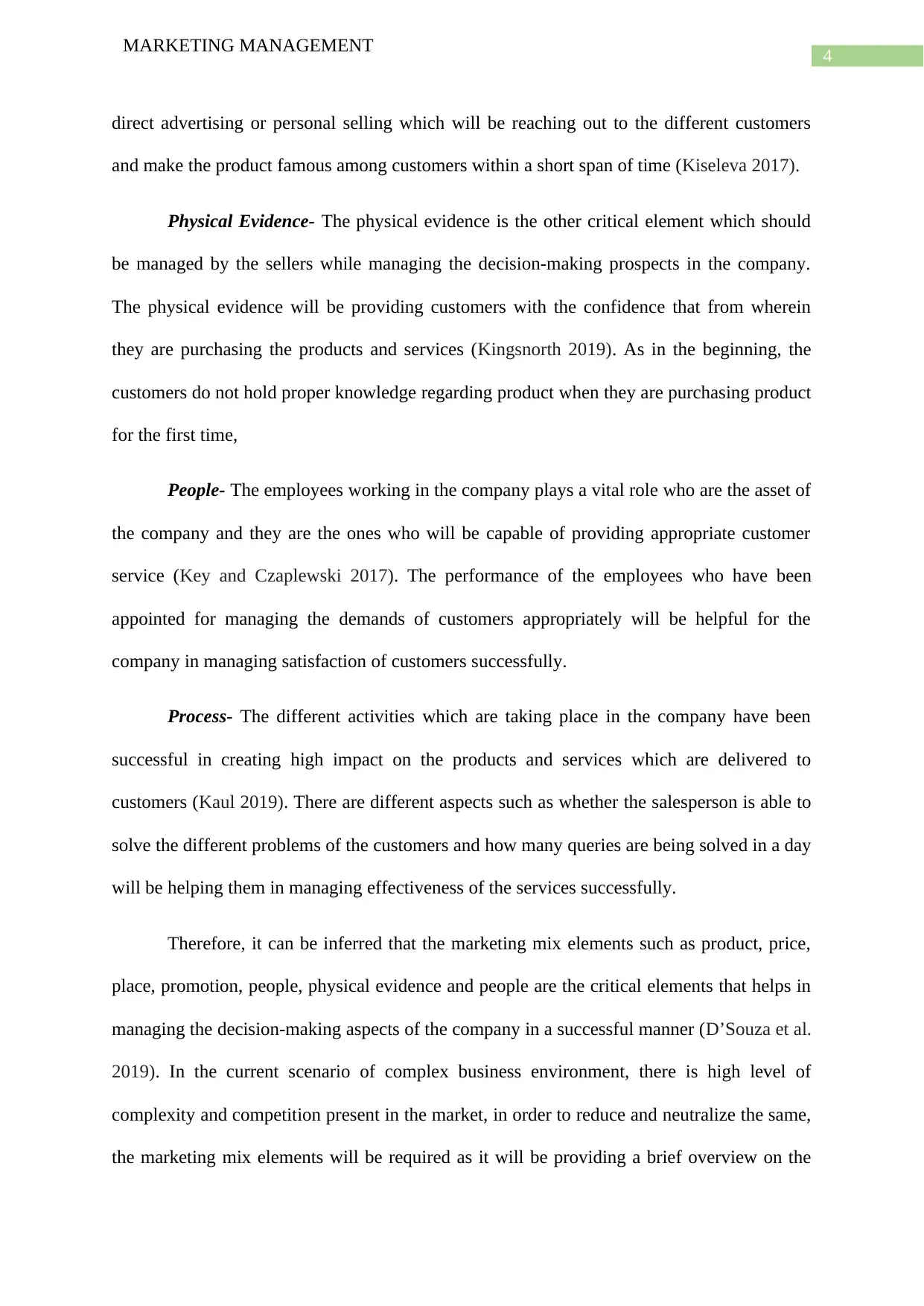
4
MARKETING MANAGEMENT
direct advertising or personal selling which will be reaching out to the different customers
and make the product famous among customers within a short span of time (Kiseleva 2017).
Physical Evidence- The physical evidence is the other critical element which should
be managed by the sellers while managing the decision-making prospects in the company.
The physical evidence will be providing customers with the confidence that from wherein
they are purchasing the products and services (Kingsnorth 2019). As in the beginning, the
customers do not hold proper knowledge regarding product when they are purchasing product
for the first time,
People- The employees working in the company plays a vital role who are the asset of
the company and they are the ones who will be capable of providing appropriate customer
service (Key and Czaplewski 2017). The performance of the employees who have been
appointed for managing the demands of customers appropriately will be helpful for the
company in managing satisfaction of customers successfully.
Process- The different activities which are taking place in the company have been
successful in creating high impact on the products and services which are delivered to
customers (Kaul 2019). There are different aspects such as whether the salesperson is able to
solve the different problems of the customers and how many queries are being solved in a day
will be helping them in managing effectiveness of the services successfully.
Therefore, it can be inferred that the marketing mix elements such as product, price,
place, promotion, people, physical evidence and people are the critical elements that helps in
managing the decision-making aspects of the company in a successful manner (D’Souza et al.
2019). In the current scenario of complex business environment, there is high level of
complexity and competition present in the market, in order to reduce and neutralize the same,
the marketing mix elements will be required as it will be providing a brief overview on the
MARKETING MANAGEMENT
direct advertising or personal selling which will be reaching out to the different customers
and make the product famous among customers within a short span of time (Kiseleva 2017).
Physical Evidence- The physical evidence is the other critical element which should
be managed by the sellers while managing the decision-making prospects in the company.
The physical evidence will be providing customers with the confidence that from wherein
they are purchasing the products and services (Kingsnorth 2019). As in the beginning, the
customers do not hold proper knowledge regarding product when they are purchasing product
for the first time,
People- The employees working in the company plays a vital role who are the asset of
the company and they are the ones who will be capable of providing appropriate customer
service (Key and Czaplewski 2017). The performance of the employees who have been
appointed for managing the demands of customers appropriately will be helpful for the
company in managing satisfaction of customers successfully.
Process- The different activities which are taking place in the company have been
successful in creating high impact on the products and services which are delivered to
customers (Kaul 2019). There are different aspects such as whether the salesperson is able to
solve the different problems of the customers and how many queries are being solved in a day
will be helping them in managing effectiveness of the services successfully.
Therefore, it can be inferred that the marketing mix elements such as product, price,
place, promotion, people, physical evidence and people are the critical elements that helps in
managing the decision-making aspects of the company in a successful manner (D’Souza et al.
2019). In the current scenario of complex business environment, there is high level of
complexity and competition present in the market, in order to reduce and neutralize the same,
the marketing mix elements will be required as it will be providing a brief overview on the
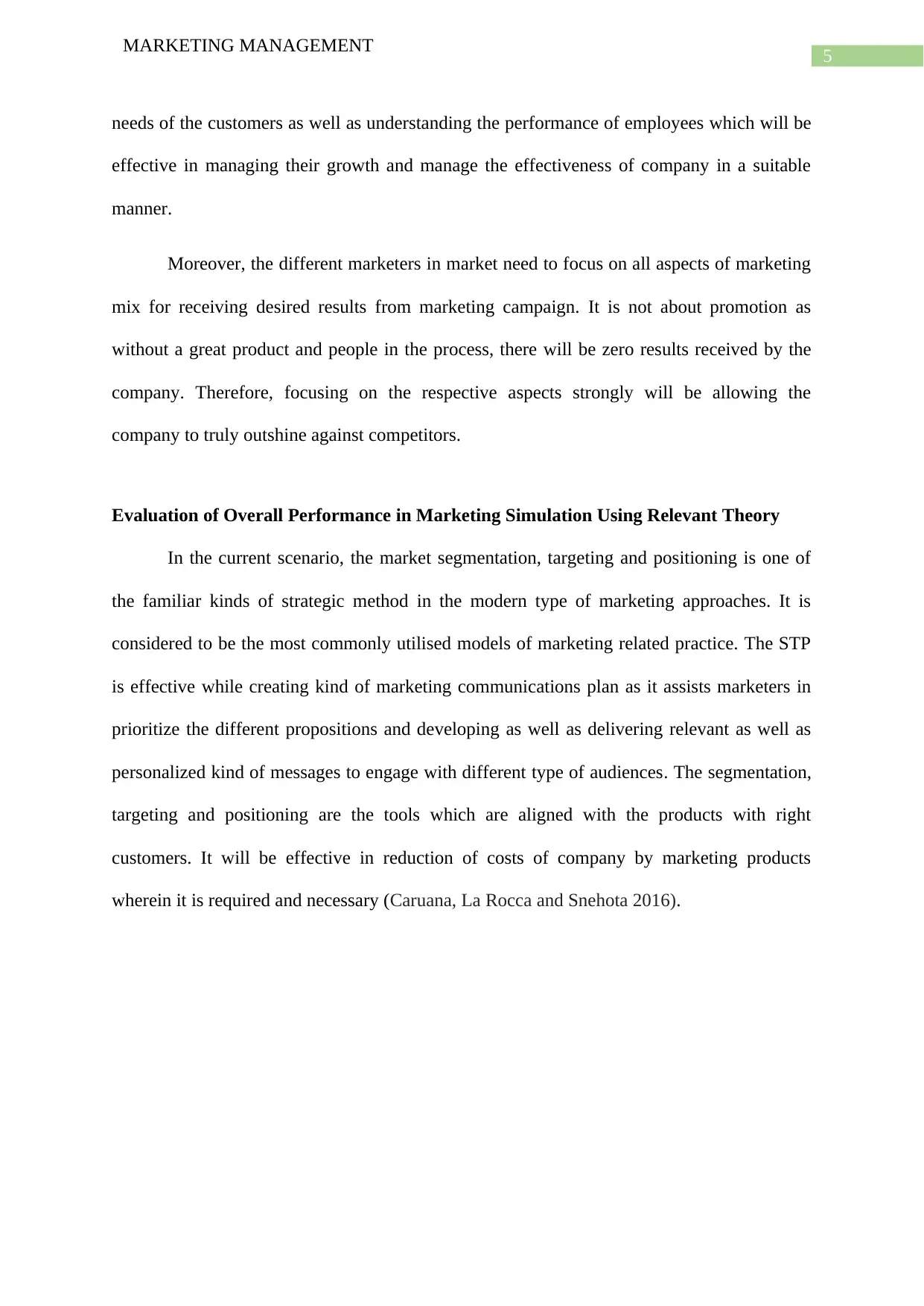
5
MARKETING MANAGEMENT
needs of the customers as well as understanding the performance of employees which will be
effective in managing their growth and manage the effectiveness of company in a suitable
manner.
Moreover, the different marketers in market need to focus on all aspects of marketing
mix for receiving desired results from marketing campaign. It is not about promotion as
without a great product and people in the process, there will be zero results received by the
company. Therefore, focusing on the respective aspects strongly will be allowing the
company to truly outshine against competitors.
Evaluation of Overall Performance in Marketing Simulation Using Relevant Theory
In the current scenario, the market segmentation, targeting and positioning is one of
the familiar kinds of strategic method in the modern type of marketing approaches. It is
considered to be the most commonly utilised models of marketing related practice. The STP
is effective while creating kind of marketing communications plan as it assists marketers in
prioritize the different propositions and developing as well as delivering relevant as well as
personalized kind of messages to engage with different type of audiences. The segmentation,
targeting and positioning are the tools which are aligned with the products with right
customers. It will be effective in reduction of costs of company by marketing products
wherein it is required and necessary (Caruana, La Rocca and Snehota 2016).
MARKETING MANAGEMENT
needs of the customers as well as understanding the performance of employees which will be
effective in managing their growth and manage the effectiveness of company in a suitable
manner.
Moreover, the different marketers in market need to focus on all aspects of marketing
mix for receiving desired results from marketing campaign. It is not about promotion as
without a great product and people in the process, there will be zero results received by the
company. Therefore, focusing on the respective aspects strongly will be allowing the
company to truly outshine against competitors.
Evaluation of Overall Performance in Marketing Simulation Using Relevant Theory
In the current scenario, the market segmentation, targeting and positioning is one of
the familiar kinds of strategic method in the modern type of marketing approaches. It is
considered to be the most commonly utilised models of marketing related practice. The STP
is effective while creating kind of marketing communications plan as it assists marketers in
prioritize the different propositions and developing as well as delivering relevant as well as
personalized kind of messages to engage with different type of audiences. The segmentation,
targeting and positioning are the tools which are aligned with the products with right
customers. It will be effective in reduction of costs of company by marketing products
wherein it is required and necessary (Caruana, La Rocca and Snehota 2016).
⊘ This is a preview!⊘
Do you want full access?
Subscribe today to unlock all pages.

Trusted by 1+ million students worldwide
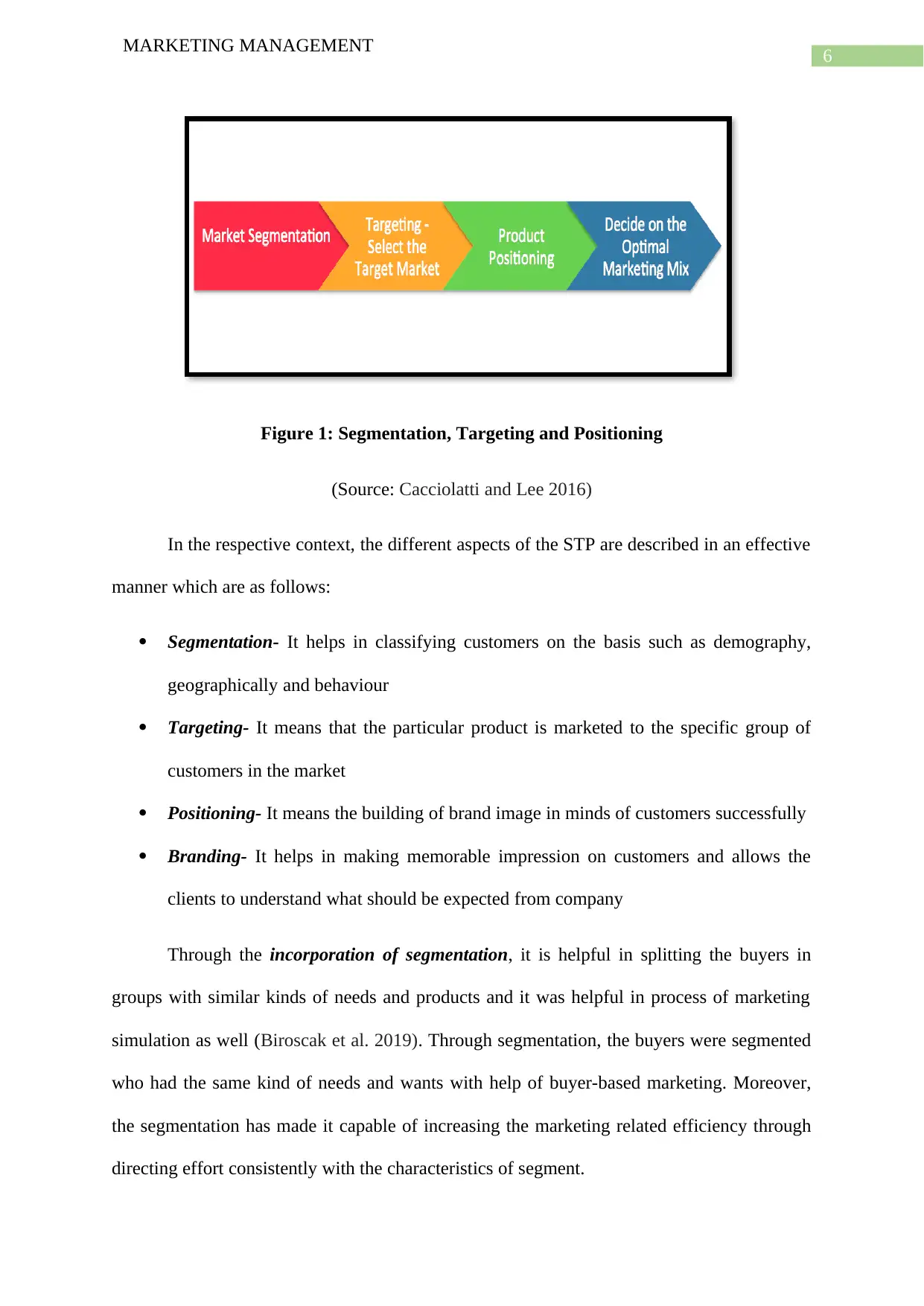
6
MARKETING MANAGEMENT
Figure 1: Segmentation, Targeting and Positioning
(Source: Cacciolatti and Lee 2016)
In the respective context, the different aspects of the STP are described in an effective
manner which are as follows:
Segmentation- It helps in classifying customers on the basis such as demography,
geographically and behaviour
Targeting- It means that the particular product is marketed to the specific group of
customers in the market
Positioning- It means the building of brand image in minds of customers successfully
Branding- It helps in making memorable impression on customers and allows the
clients to understand what should be expected from company
Through the incorporation of segmentation, it is helpful in splitting the buyers in
groups with similar kinds of needs and products and it was helpful in process of marketing
simulation as well (Biroscak et al. 2019). Through segmentation, the buyers were segmented
who had the same kind of needs and wants with help of buyer-based marketing. Moreover,
the segmentation has made it capable of increasing the marketing related efficiency through
directing effort consistently with the characteristics of segment.
MARKETING MANAGEMENT
Figure 1: Segmentation, Targeting and Positioning
(Source: Cacciolatti and Lee 2016)
In the respective context, the different aspects of the STP are described in an effective
manner which are as follows:
Segmentation- It helps in classifying customers on the basis such as demography,
geographically and behaviour
Targeting- It means that the particular product is marketed to the specific group of
customers in the market
Positioning- It means the building of brand image in minds of customers successfully
Branding- It helps in making memorable impression on customers and allows the
clients to understand what should be expected from company
Through the incorporation of segmentation, it is helpful in splitting the buyers in
groups with similar kinds of needs and products and it was helpful in process of marketing
simulation as well (Biroscak et al. 2019). Through segmentation, the buyers were segmented
who had the same kind of needs and wants with help of buyer-based marketing. Moreover,
the segmentation has made it capable of increasing the marketing related efficiency through
directing effort consistently with the characteristics of segment.
Paraphrase This Document
Need a fresh take? Get an instant paraphrase of this document with our AI Paraphraser
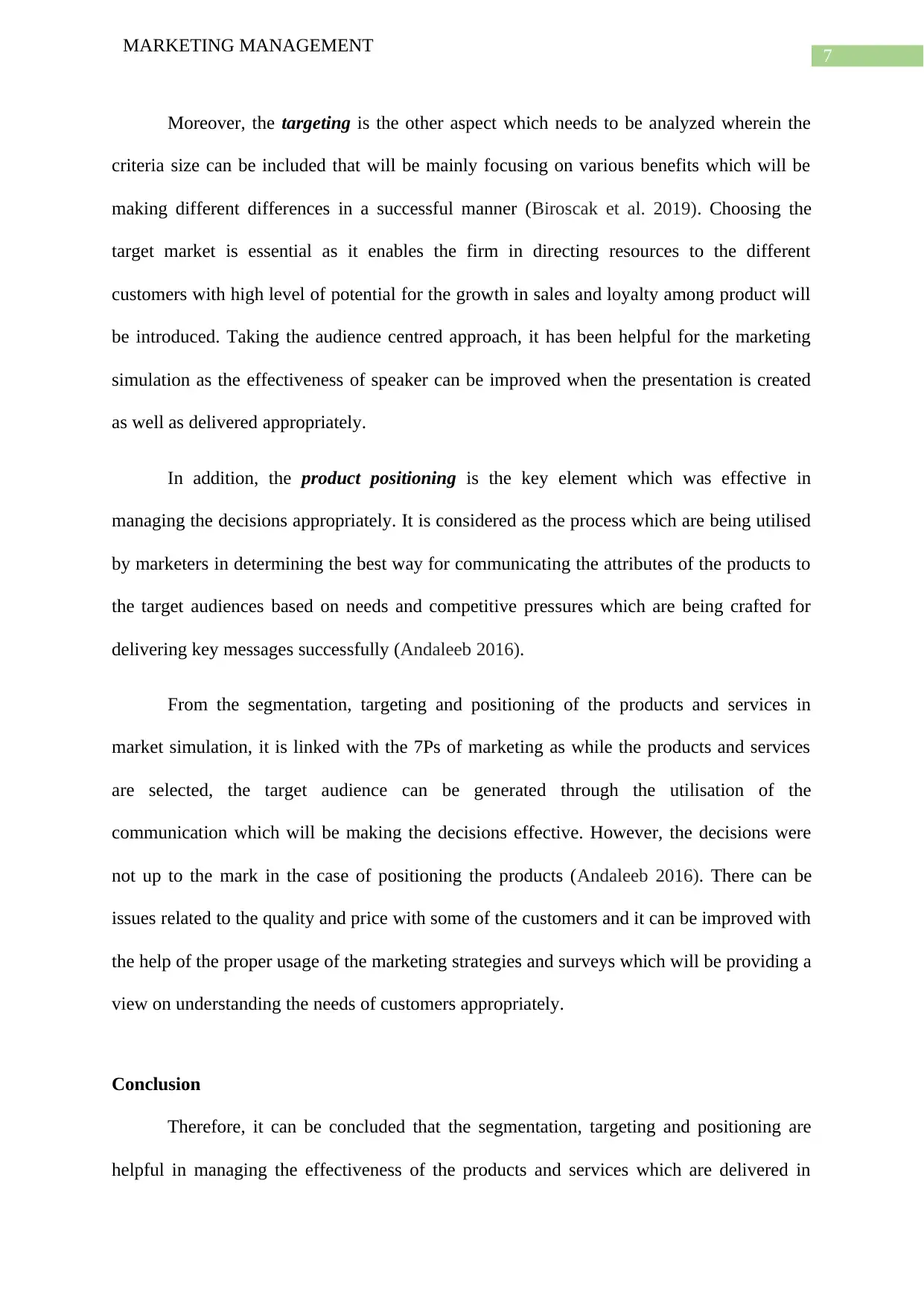
7
MARKETING MANAGEMENT
Moreover, the targeting is the other aspect which needs to be analyzed wherein the
criteria size can be included that will be mainly focusing on various benefits which will be
making different differences in a successful manner (Biroscak et al. 2019). Choosing the
target market is essential as it enables the firm in directing resources to the different
customers with high level of potential for the growth in sales and loyalty among product will
be introduced. Taking the audience centred approach, it has been helpful for the marketing
simulation as the effectiveness of speaker can be improved when the presentation is created
as well as delivered appropriately.
In addition, the product positioning is the key element which was effective in
managing the decisions appropriately. It is considered as the process which are being utilised
by marketers in determining the best way for communicating the attributes of the products to
the target audiences based on needs and competitive pressures which are being crafted for
delivering key messages successfully (Andaleeb 2016).
From the segmentation, targeting and positioning of the products and services in
market simulation, it is linked with the 7Ps of marketing as while the products and services
are selected, the target audience can be generated through the utilisation of the
communication which will be making the decisions effective. However, the decisions were
not up to the mark in the case of positioning the products (Andaleeb 2016). There can be
issues related to the quality and price with some of the customers and it can be improved with
the help of the proper usage of the marketing strategies and surveys which will be providing a
view on understanding the needs of customers appropriately.
Conclusion
Therefore, it can be concluded that the segmentation, targeting and positioning are
helpful in managing the effectiveness of the products and services which are delivered in
MARKETING MANAGEMENT
Moreover, the targeting is the other aspect which needs to be analyzed wherein the
criteria size can be included that will be mainly focusing on various benefits which will be
making different differences in a successful manner (Biroscak et al. 2019). Choosing the
target market is essential as it enables the firm in directing resources to the different
customers with high level of potential for the growth in sales and loyalty among product will
be introduced. Taking the audience centred approach, it has been helpful for the marketing
simulation as the effectiveness of speaker can be improved when the presentation is created
as well as delivered appropriately.
In addition, the product positioning is the key element which was effective in
managing the decisions appropriately. It is considered as the process which are being utilised
by marketers in determining the best way for communicating the attributes of the products to
the target audiences based on needs and competitive pressures which are being crafted for
delivering key messages successfully (Andaleeb 2016).
From the segmentation, targeting and positioning of the products and services in
market simulation, it is linked with the 7Ps of marketing as while the products and services
are selected, the target audience can be generated through the utilisation of the
communication which will be making the decisions effective. However, the decisions were
not up to the mark in the case of positioning the products (Andaleeb 2016). There can be
issues related to the quality and price with some of the customers and it can be improved with
the help of the proper usage of the marketing strategies and surveys which will be providing a
view on understanding the needs of customers appropriately.
Conclusion
Therefore, it can be concluded that the segmentation, targeting and positioning are
helpful in managing the effectiveness of the products and services which are delivered in
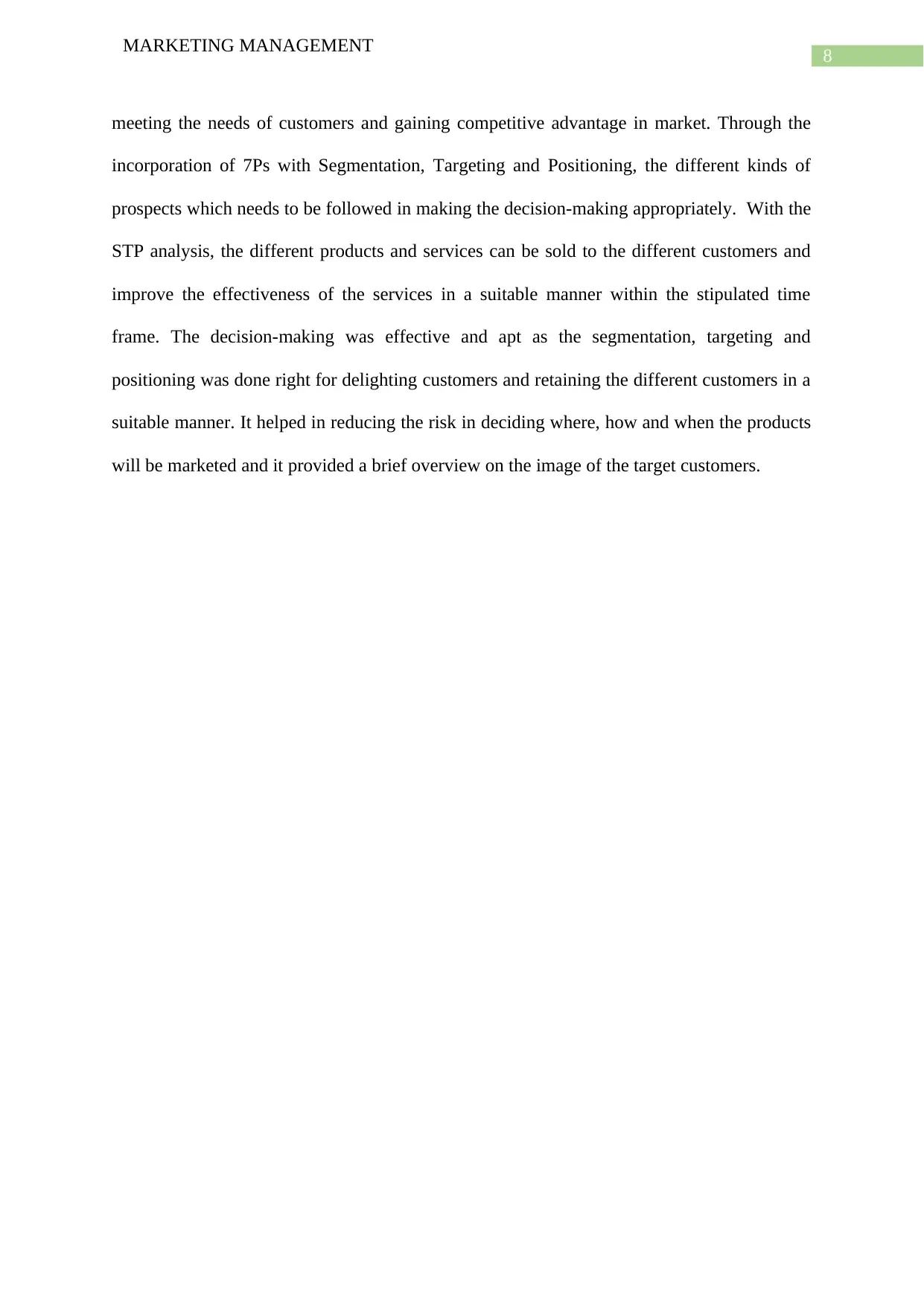
8
MARKETING MANAGEMENT
meeting the needs of customers and gaining competitive advantage in market. Through the
incorporation of 7Ps with Segmentation, Targeting and Positioning, the different kinds of
prospects which needs to be followed in making the decision-making appropriately. With the
STP analysis, the different products and services can be sold to the different customers and
improve the effectiveness of the services in a suitable manner within the stipulated time
frame. The decision-making was effective and apt as the segmentation, targeting and
positioning was done right for delighting customers and retaining the different customers in a
suitable manner. It helped in reducing the risk in deciding where, how and when the products
will be marketed and it provided a brief overview on the image of the target customers.
MARKETING MANAGEMENT
meeting the needs of customers and gaining competitive advantage in market. Through the
incorporation of 7Ps with Segmentation, Targeting and Positioning, the different kinds of
prospects which needs to be followed in making the decision-making appropriately. With the
STP analysis, the different products and services can be sold to the different customers and
improve the effectiveness of the services in a suitable manner within the stipulated time
frame. The decision-making was effective and apt as the segmentation, targeting and
positioning was done right for delighting customers and retaining the different customers in a
suitable manner. It helped in reducing the risk in deciding where, how and when the products
will be marketed and it provided a brief overview on the image of the target customers.
⊘ This is a preview!⊘
Do you want full access?
Subscribe today to unlock all pages.

Trusted by 1+ million students worldwide
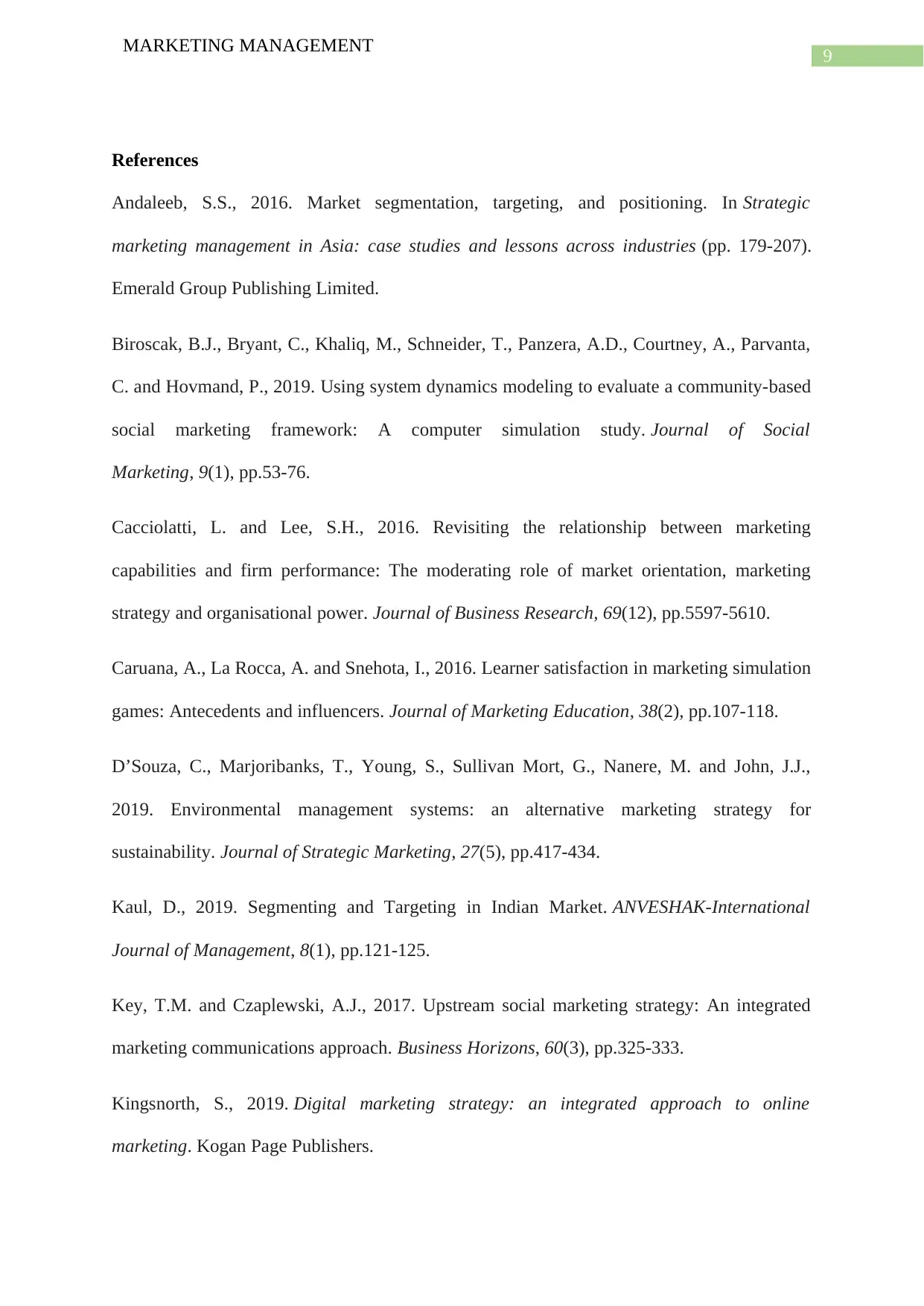
9
MARKETING MANAGEMENT
References
Andaleeb, S.S., 2016. Market segmentation, targeting, and positioning. In Strategic
marketing management in Asia: case studies and lessons across industries (pp. 179-207).
Emerald Group Publishing Limited.
Biroscak, B.J., Bryant, C., Khaliq, M., Schneider, T., Panzera, A.D., Courtney, A., Parvanta,
C. and Hovmand, P., 2019. Using system dynamics modeling to evaluate a community-based
social marketing framework: A computer simulation study. Journal of Social
Marketing, 9(1), pp.53-76.
Cacciolatti, L. and Lee, S.H., 2016. Revisiting the relationship between marketing
capabilities and firm performance: The moderating role of market orientation, marketing
strategy and organisational power. Journal of Business Research, 69(12), pp.5597-5610.
Caruana, A., La Rocca, A. and Snehota, I., 2016. Learner satisfaction in marketing simulation
games: Antecedents and influencers. Journal of Marketing Education, 38(2), pp.107-118.
D’Souza, C., Marjoribanks, T., Young, S., Sullivan Mort, G., Nanere, M. and John, J.J.,
2019. Environmental management systems: an alternative marketing strategy for
sustainability. Journal of Strategic Marketing, 27(5), pp.417-434.
Kaul, D., 2019. Segmenting and Targeting in Indian Market. ANVESHAK-International
Journal of Management, 8(1), pp.121-125.
Key, T.M. and Czaplewski, A.J., 2017. Upstream social marketing strategy: An integrated
marketing communications approach. Business Horizons, 60(3), pp.325-333.
Kingsnorth, S., 2019. Digital marketing strategy: an integrated approach to online
marketing. Kogan Page Publishers.
MARKETING MANAGEMENT
References
Andaleeb, S.S., 2016. Market segmentation, targeting, and positioning. In Strategic
marketing management in Asia: case studies and lessons across industries (pp. 179-207).
Emerald Group Publishing Limited.
Biroscak, B.J., Bryant, C., Khaliq, M., Schneider, T., Panzera, A.D., Courtney, A., Parvanta,
C. and Hovmand, P., 2019. Using system dynamics modeling to evaluate a community-based
social marketing framework: A computer simulation study. Journal of Social
Marketing, 9(1), pp.53-76.
Cacciolatti, L. and Lee, S.H., 2016. Revisiting the relationship between marketing
capabilities and firm performance: The moderating role of market orientation, marketing
strategy and organisational power. Journal of Business Research, 69(12), pp.5597-5610.
Caruana, A., La Rocca, A. and Snehota, I., 2016. Learner satisfaction in marketing simulation
games: Antecedents and influencers. Journal of Marketing Education, 38(2), pp.107-118.
D’Souza, C., Marjoribanks, T., Young, S., Sullivan Mort, G., Nanere, M. and John, J.J.,
2019. Environmental management systems: an alternative marketing strategy for
sustainability. Journal of Strategic Marketing, 27(5), pp.417-434.
Kaul, D., 2019. Segmenting and Targeting in Indian Market. ANVESHAK-International
Journal of Management, 8(1), pp.121-125.
Key, T.M. and Czaplewski, A.J., 2017. Upstream social marketing strategy: An integrated
marketing communications approach. Business Horizons, 60(3), pp.325-333.
Kingsnorth, S., 2019. Digital marketing strategy: an integrated approach to online
marketing. Kogan Page Publishers.
Paraphrase This Document
Need a fresh take? Get an instant paraphrase of this document with our AI Paraphraser
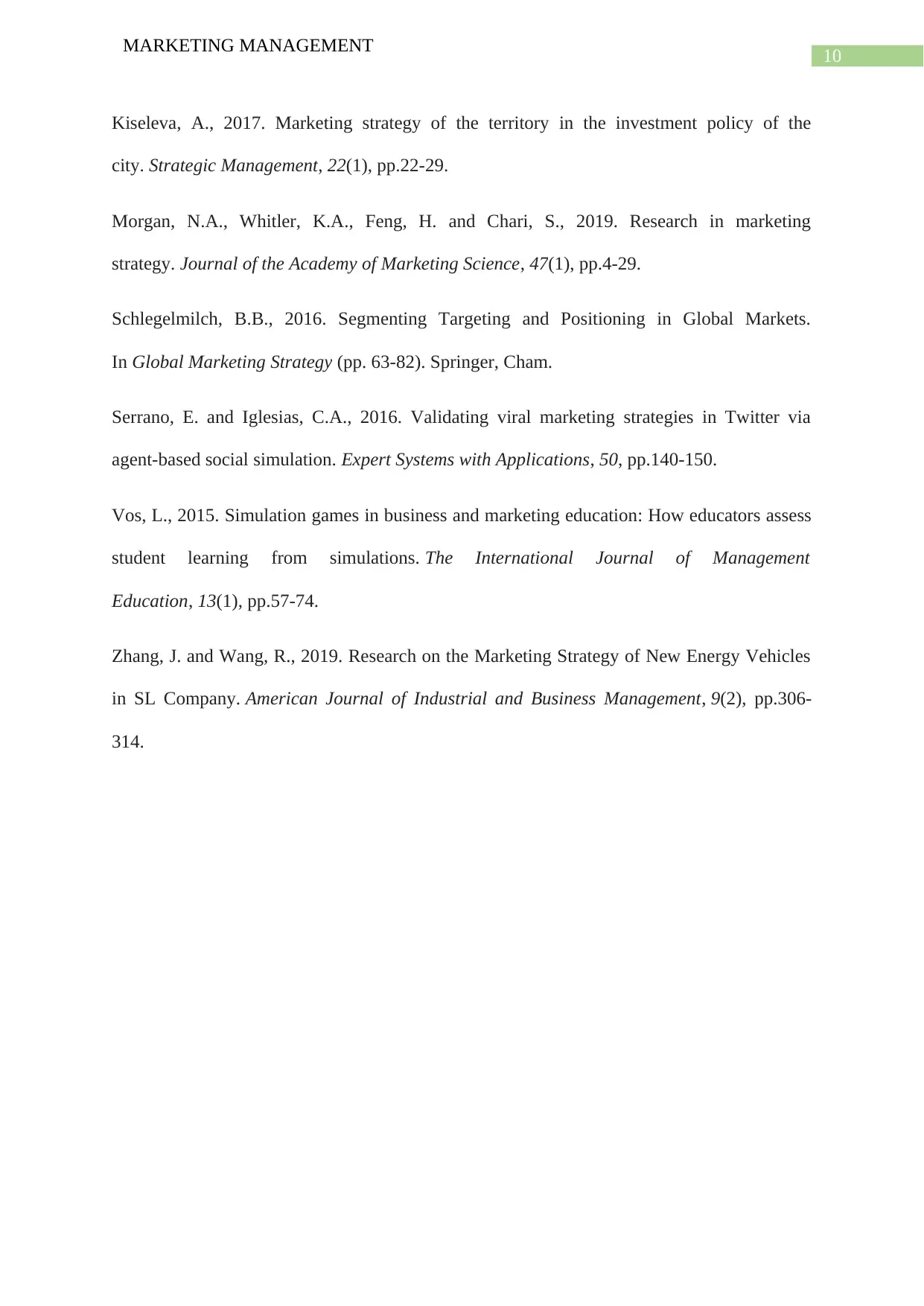
10
MARKETING MANAGEMENT
Kiseleva, A., 2017. Marketing strategy of the territory in the investment policy of the
city. Strategic Management, 22(1), pp.22-29.
Morgan, N.A., Whitler, K.A., Feng, H. and Chari, S., 2019. Research in marketing
strategy. Journal of the Academy of Marketing Science, 47(1), pp.4-29.
Schlegelmilch, B.B., 2016. Segmenting Targeting and Positioning in Global Markets.
In Global Marketing Strategy (pp. 63-82). Springer, Cham.
Serrano, E. and Iglesias, C.A., 2016. Validating viral marketing strategies in Twitter via
agent-based social simulation. Expert Systems with Applications, 50, pp.140-150.
Vos, L., 2015. Simulation games in business and marketing education: How educators assess
student learning from simulations. The International Journal of Management
Education, 13(1), pp.57-74.
Zhang, J. and Wang, R., 2019. Research on the Marketing Strategy of New Energy Vehicles
in SL Company. American Journal of Industrial and Business Management, 9(2), pp.306-
314.
MARKETING MANAGEMENT
Kiseleva, A., 2017. Marketing strategy of the territory in the investment policy of the
city. Strategic Management, 22(1), pp.22-29.
Morgan, N.A., Whitler, K.A., Feng, H. and Chari, S., 2019. Research in marketing
strategy. Journal of the Academy of Marketing Science, 47(1), pp.4-29.
Schlegelmilch, B.B., 2016. Segmenting Targeting and Positioning in Global Markets.
In Global Marketing Strategy (pp. 63-82). Springer, Cham.
Serrano, E. and Iglesias, C.A., 2016. Validating viral marketing strategies in Twitter via
agent-based social simulation. Expert Systems with Applications, 50, pp.140-150.
Vos, L., 2015. Simulation games in business and marketing education: How educators assess
student learning from simulations. The International Journal of Management
Education, 13(1), pp.57-74.
Zhang, J. and Wang, R., 2019. Research on the Marketing Strategy of New Energy Vehicles
in SL Company. American Journal of Industrial and Business Management, 9(2), pp.306-
314.
1 out of 11
Related Documents
Your All-in-One AI-Powered Toolkit for Academic Success.
+13062052269
info@desklib.com
Available 24*7 on WhatsApp / Email
![[object Object]](/_next/static/media/star-bottom.7253800d.svg)
Unlock your academic potential
Copyright © 2020–2025 A2Z Services. All Rights Reserved. Developed and managed by ZUCOL.



